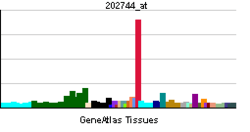SLC20A2
| View/Edit Human | View/Edit Mouse |
Sodium-dependent phosphate transporter 2 is a protein that in humans is encoded by the SLC20A2 gene.[3][4][5]
Genomics
This gene is found on the short arm of chromosome 8 (8p12-p11) on the minus (Crick) strand. It is 123,077 bases in length. The encoded protein has 652 amino acids and the predicted molecular weight of the protein is 70.392 kiloDaltons.
Function
The protein acts as a homodimer and is involved in phosphate transport by absorbing phosphate from interstitial fluid for normal cellular functions such as cellular metabolism, signal transduction, and nucleic acid and lipid synthesis.
Clinical significance
Mutations in the SLC20a2 gene are associated with idiopathic basal ganglia calcification (Fahr's syndrome). This association suggests that familial idiopathic basal ganglia calcification is caused by changes in phosphate homeostasis, since this gene encodes for PIT-2, an inorganic phosphate transporter.[6]
See also
References
- ↑ "Human PubMed Reference:".
- ↑ "Mouse PubMed Reference:".
- ↑ Kozak SL, Siess DC, Kavanaugh MP, Miller AD, Kabat D (Jun 1995). "The envelope glycoprotein of an amphotropic murine retrovirus binds specifically to the cellular receptor/phosphate transporter of susceptible species". J Virol. 69 (6): 3433–40. PMC 189055
 . PMID 7745689.
. PMID 7745689. - ↑ Bottger P, Hede SE, Grunnet M, Hoyer B, Klaerke DA, Pedersen L (Nov 2006). "Characterization of transport mechanisms and determinants critical for Na+-dependent Pi symport of the PiT family paralogs human PiT1 and PiT2". Am J Physiol Cell Physiol. 291 (6): C1377–87. doi:10.1152/ajpcell.00015.2006. PMID 16790504.
- ↑ "Entrez Gene: SLC20A2 solute carrier family 20 (phosphate transporter), member 2".
- ↑ Wang C, Li Y, Shi L, Ren J, Patti M, Wang T, de Oliveira JR, Sobrido MJ, Quintáns B, Baquero M, Cui X, Zhang XY, Wang L, Xu H, Wang J, Yao J, Dai X, Liu J, Zhang L, Ma H, Gao Y, Ma X, Feng S, Liu M, Wang QK, Forster IC, Zhang X, Liu JY (February 2012). "Mutations in SLC20A2 link familial idiopathic basal ganglia calcification with phosphate homeostasis". Nat Genet. 44 (3): 254–6. doi:10.1038/ng.1077. PMID 22327515.
Further reading
- Garcia JV, Jones C, Miller AD (1991). "Localization of the amphotropic murine leukemia virus receptor gene to the pericentromeric region of human chromosome 8.". J. Virol. 65 (11): 6316–9. PMC 250343
 . PMID 1656098.
. PMID 1656098. - van Zeijl M, Johann SV, Closs E, et al. (1994). "A human amphotropic retrovirus receptor is a second member of the gibbon ape leukemia virus receptor family.". Proc. Natl. Acad. Sci. U.S.A. 91 (3): 1168–72. doi:10.1073/pnas.91.3.1168. PMC 521475
 . PMID 8302848.
. PMID 8302848. - Salaün C, Gyan E, Rodrigues P, Heard JM (2002). "Pit2 assemblies at the cell surface are modulated by extracellular inorganic phosphate concentration.". J. Virol. 76 (9): 4304–11. doi:10.1128/JVI.76.9.4304-4311.2002. PMC 155110
 . PMID 11932396.
. PMID 11932396. - Bottger P, Pedersen L (2003). "Two highly conserved glutamate residues critical for type III sodium-dependent phosphate transport revealed by uncoupling transport function from retroviral receptor function.". J. Biol. Chem. 277 (45): 42741–7. doi:10.1074/jbc.M207096200. PMID 12205090.
- Strausberg RL, Feingold EA, Grouse LH, et al. (2003). "Generation and initial analysis of more than 15,000 full-length human and mouse cDNA sequences.". Proc. Natl. Acad. Sci. U.S.A. 99 (26): 16899–903. doi:10.1073/pnas.242603899. PMC 139241
 . PMID 12477932.
. PMID 12477932. - Bøttger P, Pedersen L (2004). "The central half of Pit2 is not required for its function as a retroviral receptor.". J. Virol. 78 (17): 9564–7. doi:10.1128/JVI.78.17.9564-9567.2004. PMC 506934
 . PMID 15308749.
. PMID 15308749. - Bøttger P, Pedersen L (2005). "Evolutionary and experimental analyses of inorganic phosphate transporter PiT family reveals two related signature sequences harboring highly conserved aspartic acids critical for sodium-dependent phosphate transport function of human PiT2.". FEBS J. 272 (12): 3060–74. doi:10.1111/j.1742-4658.2005.04720.x. PMID 15955065.
- Ravera S, Virkki LV, Murer H, Forster IC (2007). "Deciphering PiT transport kinetics and substrate specificity using electrophysiology and flux measurements.". Am. J. Physiol., Cell Physiol. 293 (2): C606–20. doi:10.1152/ajpcell.00064.2007. PMID 17494632.
